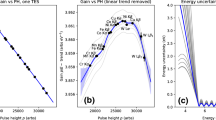Abstract
If the gamma-ray emission rate of rocks varies only with depth, the intensity recorded in a vertical borehole is mathematically predictable. The Fourier transforms of these two functions of depth relate multiplicatively via transfer functions expressible as infinite series whose terms depend on Bessel functions. The results encode readily as programs with imperceptible run times that sample the transfers regularly for use with digitized data. Separate transfers treat non-directional and directional detectors, both supposed of negligible size and located on the borehole axis. Predicting the log from a synthetic test bed confirms and illustrates the theory.




Similar content being viewed by others
References
Abramowitz, M., & Stegun, I. A. (Eds.). (1964). Handbook of mathematical functions with formulas, graphs and mathematical tables. Applied mathematics series (Vol. 55). Gaithersburg: National Bureau of Standards.
Bracewell, R. (1965). The Fourier transform and its applications. New York: McGraw-Hill.
Bristow, Q., Conaway, J. G., & Killeen, P. G. (1984). Application of inverse filtering to gamma-ray logs: A case study. Geophysics, 49, 1369–1373.
Clark, R. B., Duval, J. S., & Adams, J. A. S. (1972). Computer simulation of an air-borne gamma-ray spectrometer. Journal of Geophysical Research, 77, 3021–3031.
Conaway, J. G. (1980). Direct determination of the gamma-ray logging system response function in field boreholes. Geoexploration, 18, 187–199.
Conaway, J. G. (1981). Deconvolution of gamma-ray logs in the case of dipping radioactive zones. Geophysics, 46, 198–202.
Craig, M. (1993). The point-spread function for airborne radiometry. Mathematical Geology, 25, 1003–1013.
Craig, M. (2018). My homepage. http://members.optusnet.com.au/~towenaar/. Accessed 10 Nov 2018.
Dickson, B., & Craig, M. (2012). Deconvolving gamma-ray logs by adaptive zone refinement. Geophysics, 77(4), D159–D169.
Gunn, P. J. (1978). Inversion of airborne radiometric data. Geophysics, 43, 133–143.
National Institute of Standards and Technology (2004). X-ray mass attenuation coefficients. https://www.nist.gov/pml/x-ray-mass-attenuation-coefficients. Accessed 10 Nov 2018.
Olver, F. W. J. & Maximon, L. C.(2018). Bessel functions. https://dlmf.nist.gov/10. Accessed 10 Nov 2018.
Watson, G. N. (1943). An infinite integral. Proceedings of the Cambridge Philosophical Society, 38, 323–324.
Watson, G. N. (1980). A treatise on the theory of Bessel functions (2nd ed.). Cambridge: Cambridge University Press.
Whittaker, E. T., & Watson, G. N. (1962). A course of modern analysis (4th ed.). Cambridge: Cambridge University Press.
Acknowledgements
Author information
Authors and Affiliations
Additional information
Publisher’s Note
Springer Nature remains neutral with regard to jurisdictional claims in published maps and institutional affiliations.
Appendices
Appendix: List of Variables
I omit symbols used only fleetingly, such as \(c, h, L, \theta , \varpi \), or as summation indices, like n.
- \(a =\) :
-
Borehole radius, axis to casing
- \(b =\) :
-
Casing thickness
- \(e=\) :
-
\(\exp (1)\)
- \(i=\) :
-
\(\sqrt{-1}\)
- \(r =\) :
- s, t:
- s :
- t(z):
- \(u =\) :
-
Spatial frequency
- \(w =\) :
-
Dummy variable of integration
- \(z =\) :
-
Distance down hole from surface (except from mid-sill in Sect. 3)
- A :
-
Defined for Eq. 5, maximum value A0
- \(I(z) =\) :
-
Measured intensity
- \(I_s\) :
-
Modified Bessel function
- \({\mathcal {I}}_s\) :
-
Introduced in Eq. 13
- \(J(u) =\) :
-
Transform of I(z)
- K :
-
Defined for Eq. 5
- \(N =\) :
-
Emission rate, factor of K
- \({\mathbb {N}}\) :
-
Natural numbers \(1,2,3,\ldots \)
- \({\mathcal {P}}, {\mathcal {Q}}, {\mathcal {R}}\) :
-
Defined by Eq. 7
- \(R = s+t\) :
- T(u):
-
Defined in Eq. 2
- \(T^{(1)}(u), T^{(2)}(u)\) :
-
Transfers for spherical and linear detector
- V :
-
Rock volume with differential \(\mathrm{d}V\)
- \(\alpha =\) :
- \(\alpha , \beta , \gamma =\) :
-
Coordinates of emitting element, in Sect. 3 only
- \(\epsilon =\) :
-
Detector efficiency, factor of K
- \(\kappa , \lambda \) :
-
Defined by Eq. 6
- \(\mu , \nu , \sigma , \tau \) :
-
Defined for Eq. 5
- \(\phi , \chi , \psi \) :
- \(\varGamma\) :
-
Usual notation for the gamma function
- \(\digamma \) :
-
Defined by Eq. 6 (digamma)
- \(\varDelta \) :
-
Defined by Eq. 6
Errata
In Dickson and Craig (2012), for the denominator u in (A-3) read \(\pi {u}\). The borehole diameters on page D163 should be 10.16 and 11.43 cm.
Rights and permissions
About this article
Cite this article
Craig, M. Transfer Functions for Predicting Borehole Gamma-Ray Logs. Pure Appl. Geophys. 176, 1649–1658 (2019). https://doi.org/10.1007/s00024-018-2052-1
Received:
Revised:
Accepted:
Published:
Issue Date:
DOI: https://doi.org/10.1007/s00024-018-2052-1




